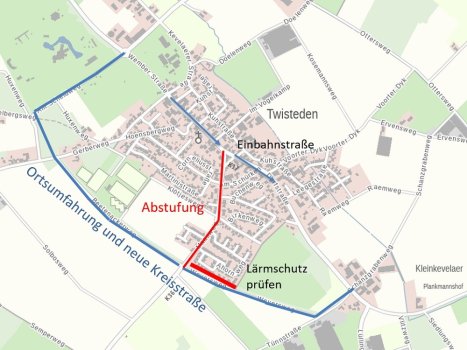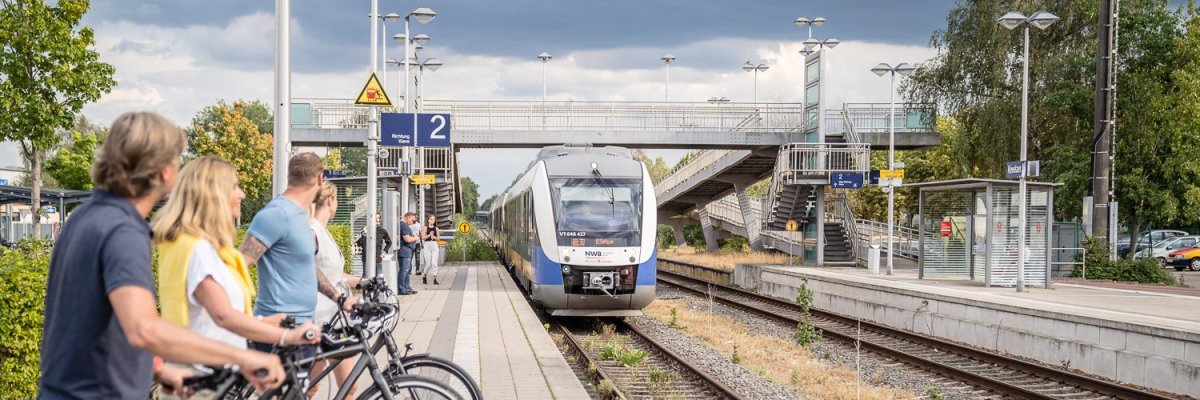Traffic planning Twisteden
The village street in Twisteden suffers from heavy traffic and there is no space for pedestrians and cyclists. There is a cycle path at the entrance and exit to the village, but not within the village. The Kleve district's construction management company (KKB) would like to close this gap. A new cycle path is to be built along the village road. To achieve this, the existing traffic space needs to be redistributed, as the village road is built on both sides. To create space for cycle and pedestrian traffic, one lane will be removed so that a one-sided two-way cycle path with footpath can be created. In future, motorized traffic will only be able to drive from Wemb to Kleinkevelaer through Twisteden.

To replace the second lane, a bypass is to be built via Tünnstraße, Weversweg, Beetenackerweg and Am Scheidweg, which will be passable in both directions. This will ensure that through traffic is diverted. Twisteden will become more bicycle-friendly and the quality of life will improve.
The plans are currently at an early draft stage. On August 24, KKB and the city of Kevelaer presented the plans to the local community. The aim was to take up suggestions from citizens in order to incorporate them into the planning process and at the same time to present the plans to the local community.
The most frequently asked questions and answers are summarized below:
The most important in a nutshell
| Questions | Answer |
|---|---|
| Who is responsible for redesigning the village road and building the bypass? | Both measures are the responsibility of Kreis Klever Baugesellschaft-GmbH, as they are district roads. |
| What role does the town of Kevelaer play? | The town of Kevelaer supports KKB in its project with local knowledge. The rest of the road network in Twisteden is the responsibility of the town. |
| Project duration | Construction of the bypass is scheduled to begin in 2025. The village road will then be rebuilt. The implementation of both measures should take a maximum of 2 years. |
| Who can I contact if I have any questions? | All inquiries can be made in writing to mobilitaet@kevelaer.de and will be forwarded from there to the right contact person. |
Village road
| Questions | Answer |
|---|---|
| Why should the village street become a one-way street? | There is no cycle path on the village road, so there is a gap in the inter-urban network. In addition, there is damage to the sidewalks and carriageway due to roots. The sidewalks do not offer sufficient space for pedestrians. In addition to the poor situation for local mobility, the village street suffers from high traffic loads from cars and heavy goods vehicles. To create space for bicycle and pedestrian traffic, a lane for cars will be removed. This allows the space to be redistributed in favor of bicycle and pedestrian traffic. A bypass will be built to replace the second lane. |
| Has a speed reduction on the village road been examined? | The village road is a district road. No road user may be excluded on such a road, which serves the supra-local development, and the speed may only be reduced if there is a particular danger. However, a reduction to 30 km/h is possible for a length of 300 m at schools or kindergartens. This reduction has already taken place and will remain in place in future. Due to the reduced road width and crosswalks, we believe that the speed will slow down automatically. |
| Which vehicles will be permitted on the village road in future? Will heavy goods vehicles still be permitted? | The village road is a district road. No road user may be excluded on such a road, which serves the supra-local development. However, the signs will direct heavy goods traffic via the bypass. |
| From where to where is the one-way street planned? | The one-way street begins at the Gerberweg/Dorfstraße/Kevelaerer Straße junction and presumably ends at Leegestraße. The exact end point is still being agreed between KKB and the administration. The aim is to avoid slow-moving traffic on other roads. |
| Why isn't the one-way street going in the other direction? | The one-way street in the direction of Kleinkevelaer can be connected to the existing cycle paths. From a cycling perspective, the other direction would be impossible. |
| How can slow-moving traffic be avoided? | The city administration is currently examining various solutions for preventing slow-moving traffic through signage or structural measures. |
| Can the one-way street concept still be overturned? | No. The term concept means that the planning is still at an early stage and not all details have been clarified yet. In order to close a gap in the cycle path network, it is necessary to convert the village road into a one-way street. If this measure is not desired, no bypass will be built. |
| How do you regulate access to the village square, store and Volksbank with the one-way street? | With the changes to the village road, the access routes will remain the same. Accessibility will be safer for pedestrians and cyclists in particular, but also for motorists, as the space will be redistributed. The traffic situation around the village square will be examined in more detail during the process |
| Irrland is changing its access road. To what extent will this have an impact? | The aim is for visitors to no longer drive through Twisteden. We will achieve this with the OU. Irrland is planning to extend the road behind the site, via which traffic will then be routed directly to the OU. Navigation devices will recommend this route over time. There will also be signs in Irrland indicating the desired route for visitors and also on the homepage. |
Bypass
| Questions | Answer |
|---|---|
| Where does the bypass run? | The existing roads Tünnweg, Weversweg, Beetenackersweg and Am Scheidweg are to be extended to form a bypass. The exact route depends on land acquisition. |
| Is there an alternative route? | No. |
| Will there be any encroachment on the edge of the site? How deep will the intervention be? | The aim of the city is not to interfere with the greening of the edge of the site. KKB is currently conducting land acquisition negotiations in order to be able to fulfill this wish of the citizens, politicians and administration. If it is not possible to widen the Weversweg in the direction of the agricultural area, the existing grassland must be removed to a width of approx. 3 m. |
| What noise protection measures are planned? | The bypass is currently being planned. As soon as the land acquisition has been completed, the specific route will be determined. A traffic forecast and, based on this, a noise forecast can then be made. Only then will it be clear which noise protection measures are necessary. |
| Will a cycle path be built parallel to the bypass? This is particularly important for young people on their way to the sports field. | No, as cycle traffic should be routed through the village. The access routes within the village to the sports field should be strengthened. A parallel cycle path would mean further consumption of agricultural land. |
| To what extent will the OU be designed so that Dutch guests do not use the old border? | The topic of the old border crossing is looked at again in order to resolve it with regard to the Gerberweg. |
| And how do you get to the Netherlands on foot or by bike? There is also a Way of St. James. | A crossing aid is being built in the Maasweg/local bypass area. |
| What speed should apply on the new bypass? | The aim is to move the town sign further towards the end of the town so that the new bypass is within the town and can be designated as a 50 km/h road. |
| When all the traffic uses the OU, it ends up at the traffic circle at Irrland. That's where the traffic will clog up again. How is that supposed to work? | Answer from Mr. Tebartz van Elst: We will move our main entrance towards the back. Then we can redesign the parking lot and get the traffic out of Twisteden by diverting the traffic beforehand. This means that there will no longer be any traffic at the traffic circle. Guests coming from the A40 or A57 will be diverted past the town before they reach us, because they are coming directly to the airport (road on the Irrland site). The navigation devices will also indicate this. We know that we are imposing a lot on the village, but we can help to relieve the traffic. For us, the planning is basically a positive development. |

